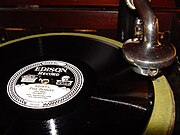Diamond Disc
The Diamond Disc (Engl., "Diamantschallplatte") is a record format developed by Thomas Alva Edison .
prehistory
Until the first years of the 20th century, the phonograph was the world's leading sound carrier format. However, the gramophone , which was largely completed by Emil Berliner in 1897 and mainly advertised by the Victor company , pushed with noticeable strength onto the still young entertainment market. The end of Edison's roller format was in sight. In addition, in 1912, the second largest roller manufacturer, Columbia Graphophone Company , switched production entirely to records .
A few years earlier, employees of the Edison laboratories had started work on their own record format. Dr. Jonas Aylsworth, former chief chemist and later advisor to Edison, developed a special material as a basis for pressing records. In particular, it should be heat-resistant and unbreakable, a property that conventional shellac records did not have.
The Edison Diamond Disc Phonograph was first presented to the public in 1911, but sales did not begin until a year later.
Manufacturing and texture
A mixture of phenol , formaldehyde , wood flour and solvent was used and a very robust board core was made from it. This core has now been coated with a layer of varnish made from synthetic resin containing phenol. The blank produced in this way then received its grooves from a die in the pressing process.
In contrast to the side script used on almost all shellac records , Edison stayed with his subscript , i.e. H. the useful signal was vertical in the groove. The diamond discs had a usual diameter of about 25 cm (equivalent to 10 ″) and were about 5 mm thick. The speed of rotation was 80 min −1 . A diamond disc cannot be played on a conventional gramophone, it would be damaged by the steel needle. Instead, Edison sold its own player, the so-called Diamond Disc Phonograph . These devices were falsely advertised as "phonographs" (= sound recorders), although there was no recording option for the consumer.

Instead of a steel needle, Edison used a diamond sapphire to scan his diamond discs, which worked with a very high contact weight of approx. 300 g. The maximum playing time was about four and a half minutes. The sound quality was significantly better compared to the shellac recordings and offered significantly more details. Piano recordings in particular sounded more convincing than from a shellac record. The Russian pianist Sergei Rachmaninow made his first recordings on Edison Diamond Disc in April 1919 , but switched to Victor shortly afterwards due to discrepancies during the publication.
1926 presented Edison the Long Playing Disc Diamond before that at 80 min -1 up to 24 minutes (10 'diameter) or 40 minutes (12' diameter) played and representing an absolute novelty. The material and the texture were identical to the normal Diamond Disc, only the groove density had multiplied. The format had to be discarded after approx. 1 year because many customers did not want to pay for the expensive retrofitting of their devices and the sound quality was significantly worse and quieter than the normal Diamond Disc. In addition, the grooves were very sensitive and the plate wore out quickly.
Up until 1927 , all Diamond Discs were recorded acoustically, without the use of microphones or amplifiers, as Edison was unable to perceive the advantages due to a hearing impairment. There were also concerns that the louder, electrical recording could cause more wear to the record during playback because the recording level was higher.
Decline
Despite the tonal advantages over the shellac record, the Edison Diamond Disc System could not prevail. The price of a diamond disc phonograph and associated records was significantly higher than that of a conventional gramophone. In addition, the company was also fixated on its own record brand, since Edison did not consider collaborating or licensing with other manufacturers. Although some manufacturers provided adapter devices with which one could also play normal shellac on the Edison device, this only contributed to the decline of the format.
In 1928 Edison's son Charles took over the company and tried to save it in 1929 by selling normal shellac records, suitcase gramophones and radios. During this time the first electric diamond disc record players with radio combination were produced. The company was not saved, however, and in October of that year it was announced that the Edison Phonograph Company was no longer in business.
The format was not pursued by other manufacturers either and is now a technical curiosity.

